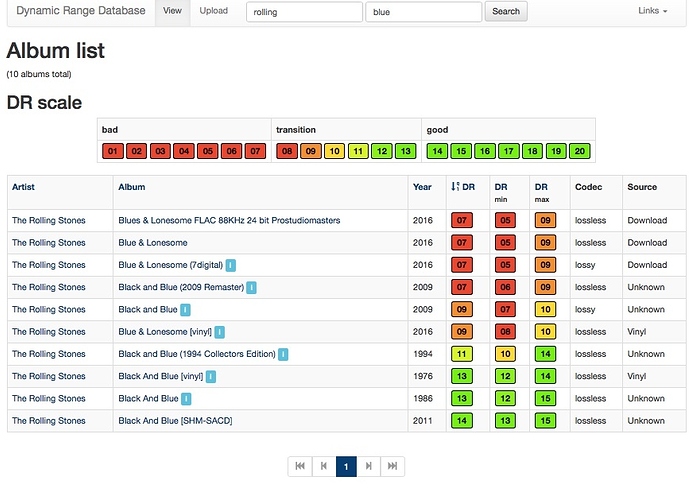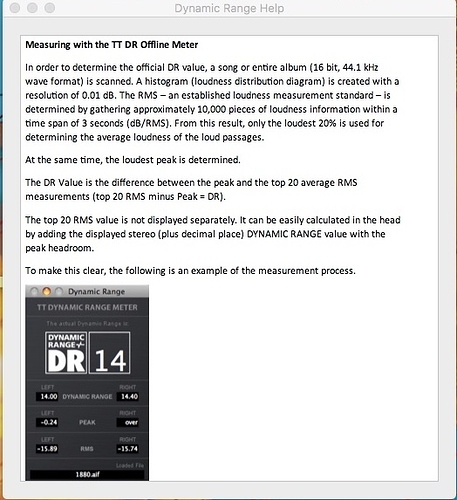Version identification. A lot of times there will be a Japan->US market release that is identical to the Japanese version for example. The track DR, peak, RMS, and overall DR can be used to match version or cross-reference to the DR db for version identification.
Also a good way to check for versions with clipping, but if possible please capture peak track L/R in the metadata because (L+R)/2 can cover up clipping.
I don’t understand why this is so usefull. I know which version of an album I bought and don’t need such an indirect identification. And the one or two albums I have in more than one version I can easily identify by naming them.
Perhaps not to you, but DR is plenty useful for many others. Aside from reasons of general interest, having DR data is of great relevance to the loudness war that continues to be a major concern for many music lovers. Having dynamic range information that is in particular compatible with the online DR database is important to many of us. I’m not sure why you insist on arguing the point. Not everyone wants all features, clearly this one isn’t for you. Doesn’t mean there aren’t valid reasons for it.
+1 Very useful for me too !
Thanks Steve.
Didn’t want to start a confrontation. I only try to understand the use case.
I’m not going to get into explaining or justifying all of the use cases for this feature but you can be sure there are many, and many that are very important to many of the Roon target market who are buying Room for the metadata and library management features beneficial to those with large, complex libraries.
To give an explanation of what “target” CDs are you can check this out:
R128 Volume Leveling is of little importance to me but the best volume levelling algorithm available would be important to others that do playlists or any type of random playback.
I have about 12,000 albums so DR values would be a very valuable tool to me as I didn’t record the specific album version information when ripping them.
@Mind_Meld, @volpone, @pedalhead – you guys are all opposing @AE67 for trying to find the use case for DR. You are right, you don’t have to justify anything to him/her. But, you do have to justify it to me ![]()
I understand the reason why dynamic range is useful, so you don’t have to argue that. The question at hand is why “DR” branded dynamic range (also known as Crest Factor DR) is more important than R128’s dynamic range calculations (that take into account momentary peaks and silences).
I explicitly asked for information about all the use cases, as I’m not seeing providing DR and R128 as important and I don’t care if you think it is important. I only care WHY you think it is important. That’s what helps me decide if we should do both, or build something different, or better.
I think you mean R128 – R128 can compute normalization information, but it also has dynamic range information.
This assumes you can get version cross referencing in an automatic manner, and that metadata can also be matched against Roon metadata.
One thing to remember here: all these “top priorities” and feature request lists are to inspire the Roon Team – but we aren’t in the business of building faster horses.
If you look at Hoffman forums historically people were using track peak data as a %… i think it came from ripping s/w to identify if versions were identical. There are a lot of ubobtanium 1st release back from when digital was new. At one point Japan was only able to press. Then it went to W Germany and the US then everywhere. So there are often equivalent masterings with completely different label/release #. So often people don’t know if they are equivalent, and whether they need to play $500 for a Black Triangle Abbey Road.
Secondly, your s/w has the provision to select a preferred version. The DR data helps in determining which version you may want to keep. For example my system has sensitive horn speakers and if I have a DR10 version and a DR 6 version in almost every case I need the lower RMS higher DR version. If a new release title turns out to have a DR5, then I know to go look into ripping vinyl.
Another example to check if a particular version contains digital clipping or “over”. Usually, I will avoid these versions if possible.
And another example is to be able to look at: Track peak and RMS, and overall DR to compare to the possible existent version using DR database. This is one example where it might be nice for the also to match that in foobar and DR database. In this case, it would rad to be able to upload data to the public data base by exporting a compatible parsed text file perhaps.
Another example is just to compare multiple versions of the same title. How many versions of Kind of Blue do I have?  Comparing amongst versions on a library it very insightful.
Comparing amongst versions on a library it very insightful.
Another example is to filter sort in “Focus” on these metrics. This is just the same use case as filter sort against any other metric.
I kinda made some of these points about 18 months ago with the original feature request, but there are numerous other examples and agreed it’s good to discuss so you can develop the features properly from the get-go. Understandable. Hope that helps.
In all, I’ve spent a good portion of three years exhaustively working on a crazy music library and these analytic tools become indispensable. To me much more so than GraceNote metadata and hyperlinks. I’ve let my sub expire waiting for this, and to a lesser extent SACD ISO. I know that will turn up another healthy debate. But those features are both important to me and the library I have. Hoping to jump back in at some point. Thanks.
I will be referring to Crest Factor Dynamic Range as CDR, and “Dynamic Range” as DR:
not unique to CDR.
also not unique to CDR.
not unique to CDR.
not unique to CDR.
Just to squash this bad information: we don’t use Gracenote.
Other things you’ve brought up:
We don’t have the L+R/2 issue because it’s a max of the inter-sample peak, not an average
We have data at the track level only…album-level display is just max(track-level) for this stuff
Both of these help you avoid music with a bad DR, but for music you don’t own. I’m not sure how that works in Roon, as Roon only has content you do own.
The only thing I’m seeing here as a possibly unique CDR feature is version identification given that their DB exists. Building that support just doesn’t make sense for version identification; it’d make more sense to do better audio fingerprinting not limited to DR only.
I can continue to use the offline tool to analyze the library I do own and stay out of the ecosystem. That’s not a problem and what I currently do. The offline tool calculates and displays L and R data but only logs the channel sum, and then another track average for overall DR metric. Often there is clipping on an individual channel that is covered up and missed in the average.

Analyzed folder: /Users/SteamPunkJunk/Desktop/untitled folder
DR Peak RMS Filename
DR8 over -8.60 dB 01 Just Your Fool.m4a
DR6 over -7.76 dB 02 Commit a Crime.m4a
DR6 over -8.16 dB 03 Blue and Lonesome.m4a
DR7 over -7.90 dB 04 All of Your Love.m4a
DR5 over -6.39 dB 05 I Gotta Go.m4a
DR7 over -8.41 dB 06 Everybody Knows About My Good Thing.m4a
DR6 over -7.07 dB 07 Ride _Em On Down.m4a
DR7 over -8.08 dB 08 Hate to See You Go.m4a
DR6 over -8.44 dB 09 Hoo Doo Blues.m4a
DR9 over -10.32 dB 10 Little Rain.m4a
DR6 over -7.19 dB 11 Just Like I Treat You.m4a
DR7 over -8.15 dB 12 I Can_t Quit You Baby.m4a
Number of files: 12
Official DR value: DR7
==============================================================================================
@danny, I think it boils down to this… As far as I can tell from being into this stuff for quite a while, when people discuss dynamic range ratings for whatever reason, it always seems to be in terms of DR. I have never encountered a discussion where R128 is used. Not to say there aren’t any out there (just pre-empting the trolls), but this is my experience.
I’m interested…what is the reason for including a dynamic range field in Roon? To leverage it for something else such as volume levelling, or simply as a matter of interest to the user? If the latter, then personally I would strongly be in favour of DR over R128 in terms of usefulness and relevance.
On the reported album value could you please consider reporting the floor of the track average, rather than the best track. Individual tracks can be outliers.
My only point is about usage: DR (Crest Factor DR) is the only « metric » commonly used to compare recordings Dynamic Range.
« Audiophiles » and music lovers use DR scale (from 1 to 20) to talk about, compare, and cross reference. See all the forums worldwide, they all talk about DR and not R128.
I don’t argue against R128 from a technical point of view and very good if Roon use it for normalization.
So, please @danny, show both (DR and R128 too) as JRiver and Audivarna.
I use DR for a quick reference on a how a potential track or album may sound due to compression during the recording process. But my understanding of R128 with Jriver is simply a sound leveling program for playback, which I never use.
Another use case is in checking that I set the gain for DSD->PCM conversion okay so that there is no clipping.
How about we take this over here guys/gals?

